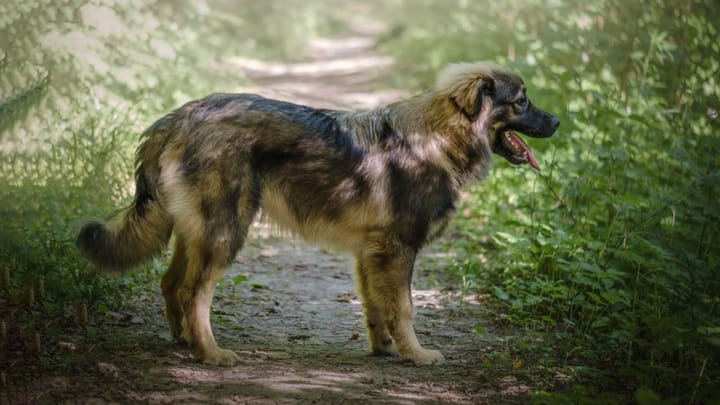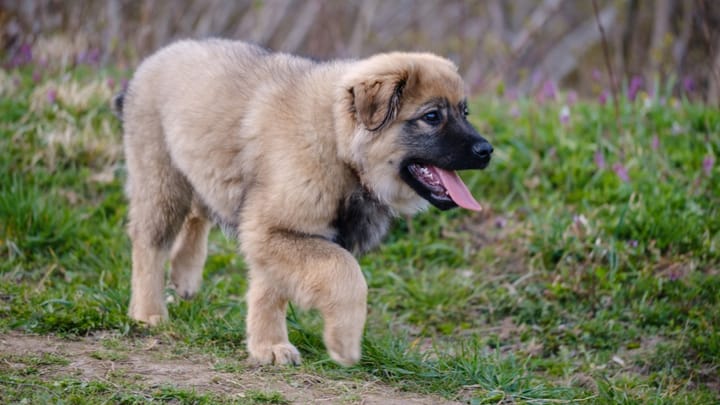Karst Shepherd Dog
Other names : Krasky Ovcar, Krasevec, Krazski Ovcar, Karst Sheepdog, Istrian Sheepdog


The Karst is a livestock guardian dog. It was originally bred in Slovenia and is still mostly used by Slovenian farmers. It is rarely seen out of its native lands but its popularity elsewhere in the world is on the rise. It is used as a herder and a guardian of livestock due to its alertness and protective nature. It is a fearsome watchdog, but an unlikely sensitive companion about the house.
|
Life expectancy |
The Karst Shepherd Dog has a life expectancy of between 12 and 14 years |
|
Temperament |
|
|
Size |
Medium
|
|
Adult size |
Female
Between 21 and 24 in
Male
Between 22 and 25 in
|
|
Adult weight |
Female
Between 55 and 82 lb
Male
Between 66 and 93 lb
|
|
Coat colour
A mix of iron grey, light grey and sandy colours. |
Blue |
|
Type of coat
The Karst has a long and abundant topcoat and undercoat. Its head and front parts of its legs are covered with shorter hair. Thick and long fur around the neck forms a mane. |
Long |
|
Eye colour
Dark brown or chestnut. |
Brown
|
The Karst has a want to be the dominant dog of a pack. If it is not taught from a young age to respect the boundaries of the hierarchy, this dog will seek to take control of the household. Consistency from its owner is required. That is not to say that the Karst should be treated unpleasantly.
More details about the Karst Shepherd Dog
Karst Shepherd Dog: Origins and history
Records of the Karst show a lineage dating back several centuries; it is mentioned in a Slovenian chronicle of 1689. The breed was officially recognised in 1939.
Physical characteristics of the Karst Shepherd Dog
A muscular and robust dog. The head is slightly large proportionally than it should be; nicely shaped and wide from the skull to the muzzle. The ears are relatively high on the head but hang against the cheek. Its sabre-shaped tail is broad and well-feathered.
FCI classification of the Karst Shepherd Dog
-
Group 2 - Pinscher and Schnauzer - Molossoid and Swiss Mountain and Cattledogs
-
Section 2 : Molossian type
Karst Shepherd Dog: Characteristics
Karst Shepherd Dog: Behaviour
Training a Karst Shepherd Dog
A firmness and confidence are needed of a trainer of this dog. The Karst is easily distracted, easily bored and will always seek to take control of a situation.
Karst Shepherd Dog: Lifestyle
Breed compatibility Karst Shepherd Dog
Karst Shepherd Dog: Purchase price
The average price for a purebred puppy of this breed is around £730. It will cost between £80 and £110 per month to keep this dog.
Karst Shepherd Dog: Grooming
This dog should be brushed two or three times a week with a pin brush and metal comb. Bath this dog only when necessary and use a mild dog shampoo.
Karst Shepherd Dog: Health
Overall the Karst is a healthy breed of dog. Its average life expectancy is 12 to 14 years.
This dog is robust, fearless and confident.
The Karst is reasonably tolerant of hot weather.
The Karst is very tolerant of cold and wet weather. The coat must be dried thoroughly after a wet walk.
If a Karst is not exercised as regularly as it should be and is fed too much human or substandard food it will become obese.
- Hip dysplasia
- Malignant hyperthermia




